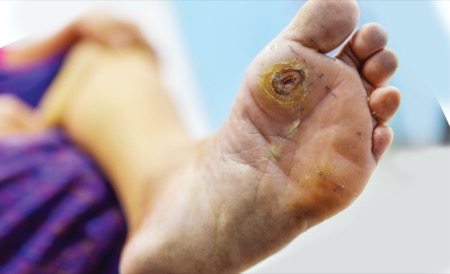The International Working Group on the Diabetic Foot (IWGDF) together with the Infectious Diseases Society of America (IDSA) updated previous guidance for the diagnosis and management of diabetic foot infections (DFIs) (Clin Infect Dis 2023 Oct 2; ciad527 doi: https://doi.org/10.1093/cid/ciad527).
The 2023 edition of the DFI guidelines is the first to combine the IWGDF and IDSA recommendations in a collaborative document, said lead author Éric Senneville, MD, PhD, a specialist in infectious diseases at the Gustave Dron Hospital, in Tourcoing, France.
Along with the increasing prevalence of diabetes—an estimated 537 million adults were living with diabetes in 2021—comes higher numbers of DFIs. These serious complications carry substantial morbidities, are the most frequent diabetes-related complications requiring hospitalization and are the No. 1 reason for lower extremity amputation (J Foot Ankle Surg 2014;53[6]:716-719).
Current data suggest that outcomes are suboptimal. One large prospective study found that at one year, fewer than half of patients presenting with infected diabetes-related foot ulcers were healed. Fifteen percent of these patients died, and 17% required amputation (Diabet Med 2018;35[1]:78-88).
Writing in Clinical Infectious Diseases, the authors said these recommendations are based on updates from two 2019 systematic reviews and 62 new studies (149 studies overall were considered). The group evaluated emerging evidence specifically to include direct and patient-centered outcomes in what they said was “improved methodology applying Grading of Recommendations Assessment, Development and Evaluation principles.”
The most significant revisions pertain to the length of antibiotic therapy in patients with severe or moderate soft tissue foot infections, endorsement of bedside percutaneous bone biopsy when there is suspected diabetes-related osteomyelitis of the foot (DFO), and a change to the definition of remission as it relates to post-treatment follow-up, according to Dr. Senneville.
The integration of new evidence-based practices concerning the use of advanced wound care modalities also stands as a notable change, according to David G. Armstrong, DPM, a professor of surgery with tenure at the University of Southern California, in Los Angeles, and the founder and co-director of the Southwestern Academic Limb Salvage Alliance. “These advancements reflect the ongoing commitment of the community to integrate scientific discoveries into practical guidelines, aiming to reduce the incidence of lower limb complications and amputations,” Dr. Armstrong said. “With some 300 or 400 new studies reviewed, I think it signals an important incremental change in how we will be treating these patients in the future. With better quality data comes better decision making for us.”
It Takes a Village
The guideline authors emphasized that managing DFIs requires a multidisciplinary team, “with careful attention to properly diagnose the condition, obtain appropriate specimens for culture, thoughtfully select antimicrobial therapy, quickly determine when surgical interventions are required, and provide any needed additional wound and overall patient care.” Simply put, evidence-based approaches can improve outcomes.
Antimicrobial stewardship was a central consideration in developing the guidelines. Dr. Senneville said the IWGDF/IDSA document contributes to those efforts by providing strict recommendations for wound sampling, avoiding the misuse of broad-spectrum antibiotic regimens and shortening patients’ exposure to antibiotics.
“We propose reducing the duration of antibiotic therapy to 10 days following surgical debridement in patients with severe or moderate soft tissue infections,” Dr. Senneville said. “In addition, new data establishing the safety of bedside percutaneous bone biopsy in those with suspected DFO has led us to support this practice.” He added that the group also backs reducing the time line for establishing remission after treatment from 12 to six months.
The guidelines contribute to antimicrobial stewardship in several important ways, according to Jason C. Gallagher, PharmD, a clinical professor and clinical specialist, infectious diseases, at Temple University, in Philadelphia. As with the previous guidelines, they reinforce the idea that uninfected ulcers should not be treated with antibiotics.
Furthermore, Pseudomonas aeruginosa is not a primary DFI-involved pathogen in most parts of the world, Dr. Gallagher said, so antibiotics active against this organism are not necessary in most cases. As noted in the guidelines, mild infections are typically caused by gram-positive organisms, and when they are not, therapy can be adjusted after cultures return without harm. “This guides clinicians to treat these organisms specifically with drugs that lack activity against gram-negative bacteria, sparing collateral damage to normal flora that are best left alone,” he explained.
Controversies, Future Directions
The guidelines close with key controversies and questions for DFI management that require further investigation (see sidebar). Dr. Armstrong said there may be differing opinions regarding the specific thresholds set for surgical interventions. “The surgical management of diabetic foot conditions is a complex domain where individual patient factors significantly influence the decision-making process. Hence, there could be areas within the guidelines that might benefit from further clarification or additional evidence to support the recommendations,” he said.
Well-designed studies are needed to address optimal DFI classification according to infection severity, according to Dr. Senneville. Other areas for future study concern “the potential benefit of molecular techniques, and the role of positron emission tomography for DFO diagnosis as well as the impact of routine bone biopsy and rifampicin in these individuals,” he noted.
Dr. Armstrong envisions that emerging investigations will place greater emphasis on measuring and managing the interdisciplinary approach to diabetic foot care, encompassing surgical, medical and technological interventions. “Research exploring the integration of innovative technologies such as remote monitoring and telemedicine in the continuum of care is paramount. Moreover, a deeper understanding of the microbiome and its implications on wound healing and infection control could unravel new therapeutic targets.”
Ultimately, the authors believe that following the new recommendations will help healthcare professionals provide better care for individuals with DFIs, prevent the number of foot and limb amputations, and reduce the patient and healthcare burden of diabetes-related foot disease.

